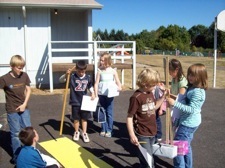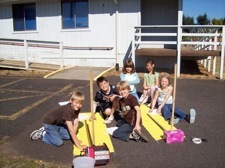
Warren, Oregon USA
September 2007
| Flag | City | Country | School | Latitude (°) +N/-S | Longitude (°) +E/-W |
|---|---|---|---|---|---|
|
|
Warren | Oregon USA | Warren Elementary School | 45.817 | -122.883 |
| Date | Gnomon | Shadow | Angle |
|---|---|---|---|
| September 21 | 100 cm | 91.5 cm | -34°40’ |
|
|
Warren | Oregon USA | Warren Elementary School | 45°49’N | 122°53’W |

Mrs. Rosenthal’s 3rd grade advance math students took on the challenge of the noon day project. In Oregon the sun comes out for brief parts of the year and primarily in the summer. We are known for our liquid sunshine. My name is Catherine Hay, a parent volunteer whose love for math gave me the opportunity to work with this group.
On our best day for sun, the students learned the basic principles of measurements with a meter stick, and how to read one.

The next step was to understand the definition of perpendicular verses parallel. This was used when we constructed our shadow measurement tool. Parallel and perpendicular with the ground were used in our math vocabulary. We grouped into two teams, which measured and recorded data. This data was then brought back to the classroom and a comparison was done. These third graders then learned about approximation and how to analyze the data. From the data they watched the measurements decrease and were able to see that as the sun gets higher in the sky the shadow measurements got smaller. They also saw the data collected by the teams were different but were still decreasing. Base on the team’s measurements they then used their skills to produce a best approximation. Rounding was used to produce the measurement of 91.5 cm.
 We then talked about what a protractor looks like and what it does. We related our findings to skateboarding. A 360 is a full circle, and a 180 is only a half of a circle. We also discussed that it is measuring degrees of an angle. We then constructed a right angle with two 100 cm sticks, which we say were perpendicular to each other to form the right angle 90 degrees. We marked our 91.5 on one stick and took a straight edge of butcher paper, from that point to the top of the other meter stick. We then measured the angle it created at the top our triangle. They came up with 45 degrees.
We then talked about what a protractor looks like and what it does. We related our findings to skateboarding. A 360 is a full circle, and a 180 is only a half of a circle. We also discussed that it is measuring degrees of an angle. We then constructed a right angle with two 100 cm sticks, which we say were perpendicular to each other to form the right angle 90 degrees. We marked our 91.5 on one stick and took a straight edge of butcher paper, from that point to the top of the other meter stick. We then measured the angle it created at the top our triangle. They came up with 45 degrees.
We then drew circles. 360 degrees. They used a protractor to mark off every 45 degree in a 360, coming up with 8.
 Because these are third graders, we used the program on the noonday site to measure the distance from our school to the equator. Our information resulted in 5075 km. They are just starting to understand their times table, so we worked on multiplying 5075 * 8 resulting in 40600 km. Not bad, considering they are learning. This then was related to the circumference around the earth, and we pulled out our globe to take another look.
Because these are third graders, we used the program on the noonday site to measure the distance from our school to the equator. Our information resulted in 5075 km. They are just starting to understand their times table, so we worked on multiplying 5075 * 8 resulting in 40600 km. Not bad, considering they are learning. This then was related to the circumference around the earth, and we pulled out our globe to take another look.
<
We then were given our partner school. This resulted in the group learning where Wharton, New Jersey is located. Because the schools are not North/South of each other, we used the program to calculate the distance from the equator for both schools.
Warren= 5075km; Wharton=4518km
We then subtracted them from one another to get 557km between them.
This then was used with the process of subtracting the schools angles. Warren at 45 degrees – 40 degrees of Wharton, to get 5 degrees. We then needed to find how many 5 degrees are in a 360. We got 72.
From this we then calculated 72 * 557= 40104 km as the circumference of the earth.
 Our group had a ton of fun and the experience gave them great pride that they were completing a project along with older math students. Many math concepts were taught in a fun learning environment. We may be little but we are math strong.
Our group had a ton of fun and the experience gave them great pride that they were completing a project along with older math students. Many math concepts were taught in a fun learning environment. We may be little but we are math strong.
Home page | Contact | Site Map | Sign In | Statistics | visits: 3612



